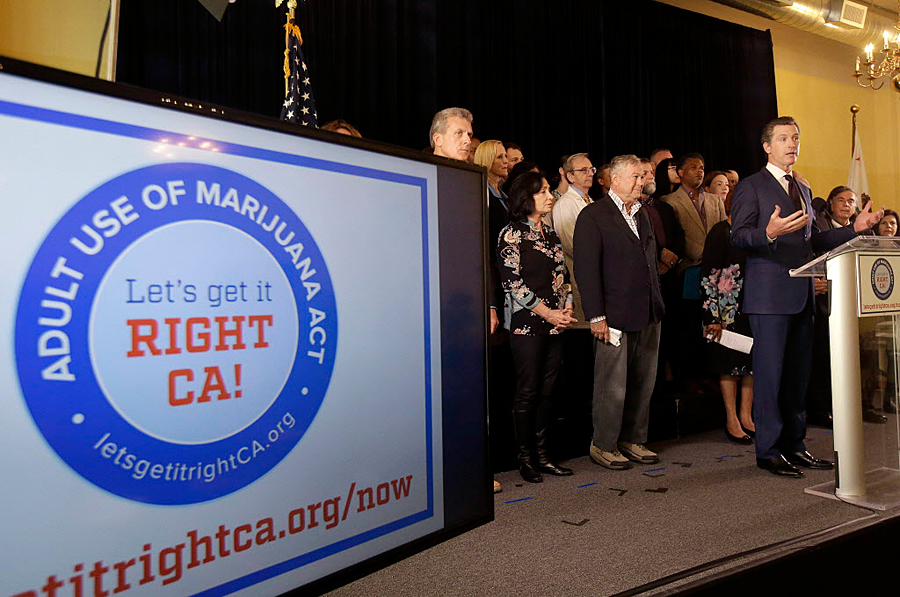California to vote on recreational pot again: What’s changed since 2010?
Loading...
California will have a second chance to legalize the recreational use of marijuana for adults over 21, after a measure to make it the first state to do so failed in 2010.
The proposed “Adult Use of Marijuana Act,” submitted by the Let’s Get It Right California! campaign, is expected to appear on the ballot November 8. The California secretary of State’s office verified a random sample of the signatures on the petition, and Secretary Alex Padilla is scheduled to officially certify the initiative Thursday.
A March poll suggests a diverse majority of Californians is in favor the legalization of marijuana. The bump from the 53 percent who said “no” to the 2010 ballot measure comes not only from the predictable demographics (younger, Democratic), but also surprising ones. The wider support shows a shift in attitudes toward marijuana in the country’s most populous state, as Colorado, Washington, Oregon, and Alaska have shown how a state and its counties and municipalities can oversee the legalization of marijuana.
“This is six years later. We’ve already seen legalization pass and be successful in other states. So it’s a different world in talking about his issue than it was,” Taylor West, deputy director of the National Cannabis Industry Association, told The Los Angeles Times.
The measure would permit those 21 years and older to possess up to an ounce of marijuana for private recreational use and to cultivate up to six plants. Consumption in public places, such as on the sidewalk and in parks, and on private property within 1,000 feet of a school or youth center while children are there would be illegal, according to the Orange County Register. The measure would also establish a system to license, regulate, and tax marijuana sales. California’s Legislative Analyst’s Office anticipates up to $1 billion in revenue from those sales, not including additional taxes counties and municipalities would be able to impose.
California was the first state to legalize the medical use of marijuana in 1996. About 19 of every 1,000 Californians are legal medical marijuana patients, according to data collected by ProCon.org, an organization that conducts research on controversial issues.
But Californians rejected the 2010 measure, which would have permitted adults to possess up to an ounce of marijuana and grow up to 25 square feet of cannabis plants. Critics worried the legalization of marijuana would exacerbate all drug use, and then-US Attorney General Eric Holder warned the Obama administration would “vigorously enforce” federal drug laws against people who grow, sell, or distribute recreational marijuana, as Brad Knickerbocker reported for The Christian Science Monitor at the time. Among the majority of voters who rejected were Republicans and Independents. Many of their stances have shifted since then.
Among the 53 percent of Californians who are in favor of legalizing marijuana, support among those over 55, Republicans, Independents, and Latinos has surged, a poll conducted in March by the Public Policy Institute of California found. Among the state’s population over 55 years old, 52 percent are in favor of the legalization of marijuana; 42 percent were in favor in 2010. Support has increased since 2010 among Republicans by 10 percent (at 44 percent) Independents by 2 percent (at 57 percent), and Latinos by 5 percent (at 42 percent) as well.
The shifting attitudes come after Colorado and Washington approved the legalization of marijuana in 2012, and Alaska, Oregon, and the District of Columbia followed in 2014.
Law enforcement and health groups, however, aren’t convinced. In addition to their concerns the new role dealers of harder drugs can have in the marijuana industry, they worry about drugged driving, which the jury is out on.
After Colorado legalized marijuana in 2012, the number of highway fatalities in which the driver tested positive for the active ingredient in marijuana increased from 23 in 2013 to 37 in 2014, according to a report released in April by the state’s Department of Public Safety. In nearby Washington, the number of fatal crashes caused by a driver who tested positive for marijuana has doubled since voters legalized pot in 2012, according to a study released Tuesday by AAA.
But a 2015 study from the National Highway Traffic Safety Administration found data “did not show a significant increase in levels of crash risk” for drivers with cannabis alone in their systems when it controlled for factors such as age and alcohol consumption, according to the Orange County Register.
Opponents of the measure have also warned that the legalization of marijuana will increase drug use among adolescents. But a Healthy Kids Colorado Survey found drug use reported by the state’s high schoolers in 2015 is comparable to the national average.
As California prepares for the vote, as well as the presidential elections, the two camps will no doubt ramp up their campaign efforts in the coming months. The “Adult Use of Marijuana Act” has $3.7 million in its coffers so far, and is backed by Lt. Gov. Gavin Newsom and former-Facebook President Sean Parker. The Coalition for Responsible Drug Policies, made up of law enforcement and health professionals, has raised about $125,000.
This report contains material from Reuters.







